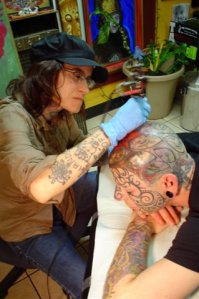Does it hurt to get a tattoo?
 Pain is defined as an unpleasant sensation. Most people avoid pain at all costs. Tattoos do hurt- but not in the way you’d think.
Pain is defined as an unpleasant sensation. Most people avoid pain at all costs. Tattoos do hurt- but not in the way you’d think.
Most people, that is, who don’t work out, diet, wear makeup or high heels, or get tattooed. The phrase “no pain, no gain” is as apt with tattooing as with any other uncomfortable act people perform for a better reward. The profit, in this case, a permanent decoration, outweighs the discomfort.
Tattoos, while painful, are not distressingly so. The pain results from surface nerves in the upper layer of skin and the hair follicles being punctured or pressed on by a group of small, hair-fine needles inserted rapidly about 1-2 mm into the skin.
Tattoo needles in a typical tattoo machine move in and out so rapidly that they can’t be seen in motion, only as a blur. The sensation is not like punctures or pokes, but more like a continuous tingling scratch. Most of the damage to the skin is from the friction of the needles’ motion, not the punctures.
During a tattoo, sensations range from mild and almost dull to very sharp and intense. When the process first begins, the body responds strongly to the sensations, releasing endorphins (the same hormones that cause a “runner’s high”) and adrenalin. Adrenalin can cause a fight-or-flight response, making the process very uncomfortable at the beginning.
Once the endorphins are absorbed by the system, however, the sensations rapidly become duller and less urgent. The pain may be just as unpleasant, but becomes less intense and attention-grabbing. This is the stage some people refer to as “numbing”. Some people even fall asleep during this stage of a tattoo.
 The endorphin rush associated with getting tattooed, or with running marathons, is notorious for becoming addictive. It is the same internal reaction that’s mimicked by the drugs ecstasy and morphine, among others.
The endorphin rush associated with getting tattooed, or with running marathons, is notorious for becoming addictive. It is the same internal reaction that’s mimicked by the drugs ecstasy and morphine, among others.
Endorphins cause a warm inner glow, like that caused by running or tanning. They block the body’s pain receptors, so while they’re in the system other pains (like a sore back, or previous injury) are also diminished. They also flood the brain with dopamines, which allow the body to recover from injury by relaxing. This after-tattoo “buzz” more than makes up for the previous pain for many people, and can account for the addictiveness of tattooing.
People who are getting their first tattoo have usually weighed the pros and cons, and are interested enough in the personal expression to be gained by applying the image to deal with some level of pain. It is for most a planned decision; and most tattooed people will say that the first tattoo they acquired hurt much less than they’d anticipated.
So why, if they think it will be so painful, would they still get it done? Most would say it’s because they wanted the tattoo badly enough not to care. Some are seeking personal pride in having conquered the pain, using mind-over-matter as a test of their willpower or inner strength. Others are already adept at dealing with physical pain, and don’t see it as an obstacle at all; and a very small group actually enjoy pain. In ten years as a professional and busy tattoo artist, I’ve only met two of these out of thousands of clients.
Some say pain is change resisted, or that pain is growth, or that beauty is suffering. In short, people are willing to suffer in order to look the way they’d like to look. They will deal with some pain in order to bring their soul to the surface.
(written by me, originally published at this link)
